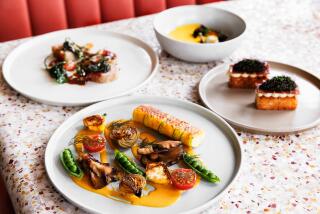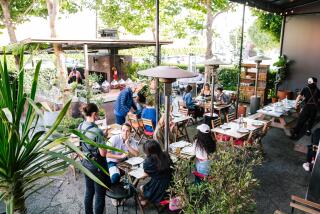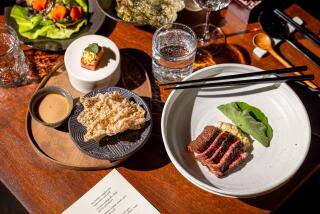Zamboanga: Place Where Orient Meets Occident
- Share via
ZAMBOANGA, Philippines — My guide, driver and soon-to-be-friend Inday (pronounced In-dye) pulled up a stool next to me at the Lantaka Hotel’s outdoor bar that faced Zamboanga’s bay. Across the Strait of Basilan the Philippine sun was setting behind the serrated scarps of Basilan Island.
We chased salty, oily peanuts down with San Miguel beer and listened to the chanting of the muezzin calling the faithful to prayer from the mosque at Rio Hondo. Just a few feet away, Badjao or sea gypsies, unloaded shells and coral from their vintas (outriggers) and stacked the souvenirs on the sea wall for sale to tourists.
Like their slender boats, the young Badjao were lean and sinewy, the sun had turned their skin chocolate brown and bleached their hair sienna. “Hey, Joe, come see, nice shells,” they beckoned to me. Since February’s “revolution” they had not seen too many Americano tourists.
Prepared to Eat
Inday, waving his hand with a flourish, called my attention to the Badjao outriggers that sailed lazily into the bay, furled their colorful sails and anchored among the cluster of vintas already in the harbor. The flames of cooking fires in the tiny boats licked the bottom of pots as families prepared to eat their evening meal.
“These people are born on these boats and die on them. They get land-sick the way that you and I get seasick,” Inday said. The Badjao are wonderful divers and fishermen but they also barter for goods.
“We call them sea gypsies because one day they may be in the harbor selling shells to the tourists, the next week they may be trading off the coast of Borneo,” he said.
Beyond the vintas , the lights of rusty tramp steamers from Malaysia, Indonesia and Singapore reflected the glassy waters of the harbor. The vessels sat offshore waiting for cargo.
Commerce, trade and smuggling are centuries-old institutions in Zamboanga, the southernmost port in the Philippines. On the southern tip of Mindanao’s finger-like peninsula, its strategic location between the Celebes Sea on the west and the Sulu Sea to the east has made it a meeting ground between Orient and Occident. Chinese traders came here as early as the 13th Century, and Moorish settlers and trade followed in the 15th Century.
The name Zamboanga is a result of cross-cultural currents, most likely the Spanish corruption of sambuan , the Malay word for the long wooden pole used by the Badjao to maneuver their vessels.
Zamboanga is a hot, dusty port with 390,000 inhabitants. Like all Filipino cities, it teems with traffic, tiny motorcycles with sidecars, masses of pedestrians, bicycle-drawn carts and marauding jeepneys.
In the heart of town is Plaza Pershing, named after the most famous American military governor of the region, Brig. Gen. John (Blackjack) Pershing who went on to distinguish himself in World War I.
One can easily get around town by taxi (fares are cheap), but I had the fortune of being driven around by Inday in his battered car that he dubbed Red Rider.
The most arresting symbol of Islam in Zamboanga is the dazzling mosque whose silvery domed minarets tower over the Muslim enclave of Rio Hondo, a community of precarious-looking stilt houses built over the shallow waters of the bay. Rio Hondo means “deep river” in Spanish. It is inhabited by sea gypsies and the Samal, a group that specializes in fishing, mat weaving and selling tropical fruits at the market.
For all the colorful history attached to the barter trade, the barter market here is a prosaic shed covering numerous cubicles. Most items are mundane: clock radios, umbrellas and other sundries are the norm but more exotic objects are available.
Inday led me through a labyrinth of stalls where we paused to speak to a man named Jose. I bought batik that hung from the walls of his booth at a more than reasonable price. It was embarrassingly inexpensive.
Inday sensed my hesitation and said, “If you want to pay him more you can, but I wouldn’t worry. He has some very good connections. He will make a profit, I can assure you.”
The bustling public market, which is divided into sections for produce, fish, meat and dry goods, is best seen during the cool hours of the morning.
The seafood market is an immensely long boulevard of stalls selling every conceivable creature dragged from the ocean--pancake-flat bottom fish, slender fish with pointy snouts, limp heaps of squid, masses of octopus, stacks of stiff tuna, mounds of prawns, fleshy chunks of moray eel, piles of mussel and live crab, their pincers trussed with twine.
A winding, 15-minute drive from town along a narrow gorge took us to a palm-studded river valley called Freedom Park. It is a recreational area where one can picnic or swim in the river but more importantly it contains several well-visited monuments. Two are dedicated to World War II, “The Guns of Aggression” (two Japanese naval cannons) and the inevitable “Tomb of the Unknown Soldier.” The most poignant monument is a recent addition built by former Mayor Cesar Climaco. It is a bas-relief vividly depicting the assassination of Benigno Aquino.
Climaco, an outspoken critic of Ferdinand Marcos who constructed the monument while Marcos was still in power, was gunned down by unknowed assailants on the streets of Zamboanga.
On the way back to town I expanded my souvenir collection at the Yakan weaving village, a short detour off the main road. For sale is strikingly colorful hand-woven cloth made by women sitting on bamboo slatted floors, painstakingly working their looms.
I plunked down a few dollars for several exquisite runners that I later framed. The distinctive cloth is also made into sashes, bags and tablecloths. The only change in their product over the last 300 years is that the Yakans now use cotton yarn instead of the Chinese silk that once came on the junks bringing goods for the Spanish galleon trade.
At 8 p.m. sharp, the Red Rider arrived at the hotel, which signaled the beginning of Inday’s famous “Evening Orientation Tour.” (“The Peace Corps guys and diplomats love this tour,” he assured me.)
Our first stop was the Alvar restaurant, a roadhouse with woven mats covering the walls, overhead fans out of “Casablanca” and an open window inviting the sea breeze. The local delicacies are cuchara , a deep-sea crab smothered in coconut sauce; ambalaya , a bitter melon mixed with pork and prawn, and tiny deep-fried shrimps dipped in hot sauce and eaten (shell and all) like potato chips.
After dinner we hopped into the Red Rider and dodged chuck holes en route to Zamboanga’s bright lights. Inday ran down a litany of choices: bars, massage parlors, discos, after-hours joints, hotels that charge by the hour, and approximate prices for all of the above. He stated everything matter-of-factly and made no attempt to pander. It was, after all, part of the orientation process.
We passed at least four establishments and settled on La Vida, a dimly lit nightclub with rickety chairs and throbbing music that was too loud and too distorted. On stage a bored looking Filipina beauty in a skimpy bikini bumped and grinded to a tune called “Body to Body,” a popular American tune. The place was practically empty.
I ordered two overpriced beers (which were still cheap) and we wiled away the hours watching the dancers or “models,” as they are euphemistically called. After a series of more go-go girls and disco hits, we decided to call it quits.
Inday dropped me off at the hotel and drove wearily home to his eight children and wife, who no doubt would be sound asleep in bed.
From Manila there are daily flights to Zamboanga for $104 round trip. Best place to stay is the Lantaka Hotel ($25 double), which is clean and adequate but not luxurious. The food is good. Best place to eat is Alvar restaurant but also try the Aristocrat, Alban, Country Kitchen and Antonios. Average price of a meal (with beer) is under $4, and seafood is fine.
Nearly everyone speaks English. Being farther south than Manila, Zamboanga has a generally drier weather pattern than the northern islands.
More to Read
Sign up for The Wild
We’ll help you find the best places to hike, bike and run, as well as the perfect silent spots for meditation and yoga.
You may occasionally receive promotional content from the Los Angeles Times.






